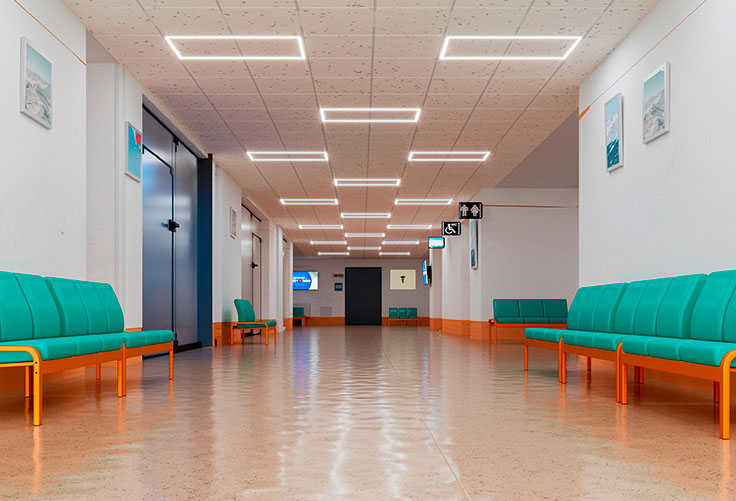Healthcare systems across the country are looking for ways to reduce their expenses. While it would be nice to live in a world in which hospitals and healthcare facilities didn’t need to worry so much about money, the reality is these systems work hard to strike a balance between reducing costs and providing the best care for their patients.
In this ongoing effort to find ways to save money, one exciting frontier is in the world of energy efficiency. As just a single example, NorthBay VacaValley Hospital was able to save 29,000 kilowatt-hours per year by installing a smart, energy-efficient lighting system. With such a tremendous savings potential, there’s good reason for healthcare facilities to take note.
It also means a huge opportunity for ESCOs and contractors. Given that there are more than 6,000 hospitals in the United States and many more healthcare and nursing facilities, we see an enormous potential in demand for energy-efficient lighting.
To meet this demand, however, it’s important to understand how healthcare lighting is different, what facilities are actually looking for, and who you need to buy in. That’s why we created this guide.
Get the E-book: How to Sell LED Lighting for Healthcare
To jump to a specific section, click on one of the links below.
Table of Contents:
Understand Why They’re Looking for Healthcare Lighting
Understand Who You Must Convince in the Organization
Understand Common Healthcare Use Cases
Selling Advanced Features
8 Questions to Ask When Working With a Healthcare Facility
Benefits of Litetronics Products in Healthcare Settings
Understand Why They’re Looking for Healthcare Lighting
 If you’re going to sell lighting to a hospital or healthcare facility, it’s important that you understand the motivations that drive them — the “why” behind their decisions. When you demonstrate you’re knowledgeable about their biggest concerns, they’ll be more likely to look to you for solutions.
If you’re going to sell lighting to a hospital or healthcare facility, it’s important that you understand the motivations that drive them — the “why” behind their decisions. When you demonstrate you’re knowledgeable about their biggest concerns, they’ll be more likely to look to you for solutions.
Energy Savings Help Reduce Overall Costs
When we say energy costs are a driving factor, how much money are we actually talking about?
Quite a bit, actually: The average hospital in the United States pays more than $72,000 per month on electricity, and lighting alone accounts for nearly 30% of those total energy expenses.
Part of the reason that number is so high is that hospitals have a difficult time keeping up with infrastructure updates. While energy-efficient LED lighting has been on the market for years, many hospitals still rely on outdated halogen, fluorescent, and other inefficient forms of lighting.
But if you make a clear case for the ROI of LED lighting, in addition to the tax and rebate incentives that sweeten the pot, you’ll certainly get their attention.
Healthcare Facilities Need Simple, Flexible Controls
 In addition to the superior efficiency LED lighting offers, smart controls can further enhance savings. But from the perspective of healthcare providers, one of the strongest selling points is ease. Smart lighting systems offer simple, flexible controls that support energy savings while leaving doctors and nurses free to focus on patients. Some key features to highlight include:
In addition to the superior efficiency LED lighting offers, smart controls can further enhance savings. But from the perspective of healthcare providers, one of the strongest selling points is ease. Smart lighting systems offer simple, flexible controls that support energy savings while leaving doctors and nurses free to focus on patients. Some key features to highlight include:
- Occupancy sensors that switch lights off when no one is using a room.
- Group editing controls that make it easier to adjust each light individually.
- Daylight harvesting that detects natural illumination and adjusts lights accordingly.
The main thing to remember here is that healthcare facilities need to save money, but they’re also looking for ways to save time. Focus on how your project can help them do both.
Healthcare Facilities Strive to Be Inclusive of All Patients
To provide the best possible care to their patients, healthcare facilities strive to create supportive, inclusive environments. Those efforts can be undermined if a facility is using outdated lighting that can cause difficulty for people with sensory issues.
Flickering lamps and outdated fluorescents can aggravate sensory issues, especially in children with special needs and autism. As many schools have already discovered, LED lighting can go a long way toward helping create a soothing, more inclusive environment. That includes dimmability and other adjustable settings to create a more comfortable environment — an important factor in creating positive outcomes for patients.
Understand Who You Must Convince Within the Healthcare Facility
If you’re going to sell healthcare lighting, it’s important to understand the inner workings of healthcare organizations. Who will you need to convince, and what are their priorities?
Let’s take a closer look at the people you may be selling to.
Facilities Management and Maintenance
 While physicians and nurses focus on patients, it’s up to the facilities management and maintenance department to ensure the healthcare environment is safe, secure, and well-maintained. This department works with contractors on any projects within the facility, both to oversee execution and to ensure code and regulatory compliance.
While physicians and nurses focus on patients, it’s up to the facilities management and maintenance department to ensure the healthcare environment is safe, secure, and well-maintained. This department works with contractors on any projects within the facility, both to oversee execution and to ensure code and regulatory compliance.
To sell to this department, it helps to be prepared for their chief concerns:
- Do you understand lighting and safety protocols for healthcare facility renovations?
- Will upkeep of the new lighting system be simple, or will it cause their team headaches?
- Can simple issues be resolved quickly and by personnel on-site?
- Will the new lighting system take longer to repair than what they have now?
- What will be the maintenance and upkeep costs of the new system?
If you show you’re prepared for these questions and that a new lighting system is better than the one they have now, you can more easily get them on board with your project.
Operations Managers
 In healthcare facilities, operations managers are tasked with balancing costs against providing the best possible care to patients. When it comes to your project, they want reassurance that you’re providing the most future-proofed solution possible — something that’s worth the investment. At the same time, they’ll want to know the overall cost of your project, along with information on energy savings, rebates, and warranties.
In healthcare facilities, operations managers are tasked with balancing costs against providing the best possible care to patients. When it comes to your project, they want reassurance that you’re providing the most future-proofed solution possible — something that’s worth the investment. At the same time, they’ll want to know the overall cost of your project, along with information on energy savings, rebates, and warranties.
In other words, you want to provide operations managers with the full picture of the project’s cost and return on investment. Here are some of the questions you should expect:
- How will a new retrofit project fit into their budget?
- How long should they expect your project to take?
- What kind of energy savings can they expect?
- What updates need to be made to ensure the facility is fully up to code?
When you can demonstrate that your project is good for the bottom line as well as for patients, you’ll have their attention.
On-Staff Energy and Sustainability Managers
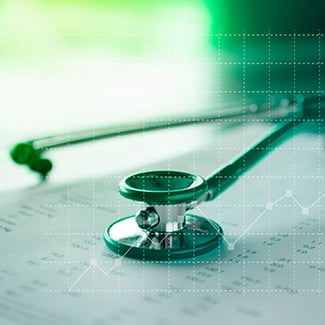 As sustainability continues to be a concern among healthcare providers, you may discover some have hired staff specifically dedicated to eliminating waste and reducing energy use. This role may also be responsible for ensuring sustainability compliance or compliance with an ESG program.
As sustainability continues to be a concern among healthcare providers, you may discover some have hired staff specifically dedicated to eliminating waste and reducing energy use. This role may also be responsible for ensuring sustainability compliance or compliance with an ESG program.
An LED retrofit might seem like an easy sell to this audience, but it’s important for you to be prepared for the questions and concerns they might have. That includes:
- Questions about qualifying for rebates and other incentives
- Concern over code compliance
- Questions about the rated life of the product(s) you plan to install
- Questions about occupancy sensing, scheduling, and other energy-saving custom controls
- Concerns over waste or disposal of existing light fixtures
To win over this audience, be prepared to highlight what makes LEDs such a wonderful choice for helping healthcare facilities achieve their sustainability goals.
Related Reading: How Are Smart Lighting Products Being Used in Healthcare?
Understand Common Healthcare Use Cases
Few buildings use lighting in settings as disparate as hospitals and healthcare facilities. From the soothing overnight lighting of a patient room to the bio-safe lights used in surgical theaters, the needs are wide and varied. Here are a few of the most common use cases you can expect.
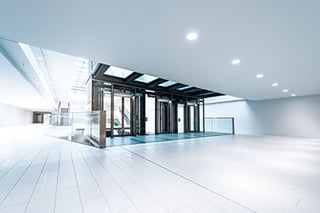 Hallways and Waiting Rooms
Hallways and Waiting Rooms
For the safety of both patients and staff, hallways and waiting rooms should be brightly but comfortably lit. In healthcare facilities that don’t operate 24/7, occupancy sensors or automatic shutoffs can be a great addition to help save energy.
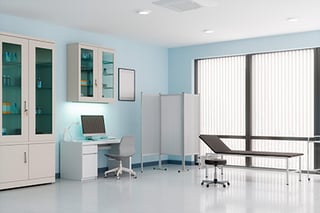 Exam Rooms
Exam Rooms
Depending on the type of facility, exam rooms may need multiple lighting options available. Physicians and nurses need well-lit environments to examine patients, but dimmable lighting is also necessary for certain tests (or for patients with light sensitivities).
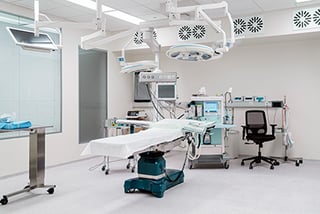 Procedure/Surgery
Procedure/Surgery
For rooms where procedures or surgeries will be performed, it’s critical for patient wellbeing that lighting is bio-safe and compatible with surgical or imaging equipment. These lights should be dimmable and have a high color rendering index (CRI) to ensure physicians can properly identify blood from tissue and see any color changes during the procedure.
 Lab/Pharmacy
Lab/Pharmacy
In pharmacies and labs, high-quality lighting is important for patient safety. Lab reports and prescription labels often have small text that requires excellent light to be properly read. Likewise, a high CRI rating is recommended to ensure medical personnel can properly identify drugs, fluids, and tissue samples.
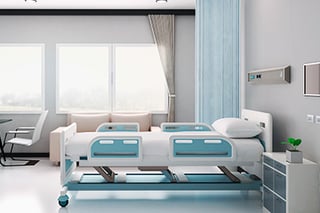 Patient Rooms
Patient Rooms
Patients need to be comfortable if they’re going to recuperate. Patient room lighting should be warm and bright enough for physicians and patients alike to see clearly. Smart controls are also helpful to ensure lighting automatically adjusts at night to allow patients to get some good rest.
 Cafeteria
Cafeteria
Cafeteria lighting should be bright, warm, and welcoming. Occupancy sensors are also a good idea to help conserve energy during off-hours when it may not be busy. (We also recommend using bulbs with a high CRI rating — hospital food gets a bad-enough rap without the lighting making it worse.)
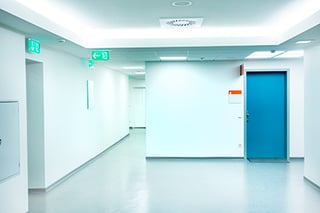 Emergency Lighting
Emergency Lighting
When the power goes out, hospitals can’t simply suspend operations. Far from it: They need to ensure that their emergency lighting is powerful and reliable enough that they can continue providing patient care until the power is restored. Lives may depend on it.
Selling Advanced Features
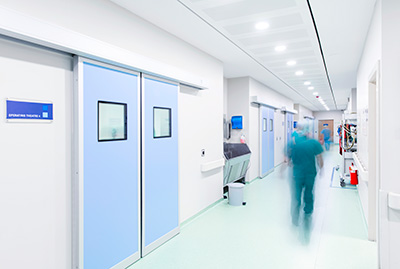 We’ve already touched on some of the ways advanced lighting features can benefit a hospital or healthcare facility, but these features merit a more in-depth discussion. That’s because they can help increase the ROI for new lighting while providing immediate benefits to healthcare staff and patients alike.
We’ve already touched on some of the ways advanced lighting features can benefit a hospital or healthcare facility, but these features merit a more in-depth discussion. That’s because they can help increase the ROI for new lighting while providing immediate benefits to healthcare staff and patients alike.
Let’s take a closer look!
- Occupancy Sensing
The top priority for doctors and nurses is taking care of their patients. They don’t have time to go room to room turning off lights that aren’t needed. Unfortunately, without smart controls, this can mean energy is wasted. Motion detectors on modern lighting systems reduce waste automatically by dimming or turning off lights when a room is not being used. They also switch lights on when someone comes in — a big help in urgent care situations. - Group Editing
Some large facilities are set up to have enormous banks of lights controlled by a single switch. For hospitals and healthcare facilities, this just doesn’t make sense. Group editing is a smart lighting option that allows users to control each light individually. This makes it easy to adjust specific areas for ideal patient comfort or to dim and brighten a room as needed. - Daylight Harvesting
One of the best ways to save energy is to brighten a room with natural light. But, as we’ve mentioned before, healthcare staff simply don’t have time to adjust artificial lighting based on how sunny it is. That’s why daylight harvesting with photo sensors is such a big deal. These sensors can detect natural illumination and adjust artificial lighting accordingly. Like occupancy sensors, this helps healthcare facilities save money without relying on staff to spend time adjusting the lights.
What do all these advanced features have in common? They make saving energy simple and automatic and help healthcare personnel keep their focus on patients.
Related Reading: Bright Ideas on Installing Dimmable LED Lighting
8 Questions to Ask When Working With a Hospital or Healthcare Facility
 With lighting projects like this, it’s important to have all the facts up front. Miscommunications or incomplete information can result in losing the bid or in problems downstream when the project is already underway.
With lighting projects like this, it’s important to have all the facts up front. Miscommunications or incomplete information can result in losing the bid or in problems downstream when the project is already underway.
Here are eight questions you need to be sure that you ask and the reasons why they’re important.
Question 1: What’s being replaced or updated?
Why You Should Ask: This might seem self-evident, but before you can quote out a bid or start planning a project, you need a full understanding of what the hospital or healthcare facility wants to have done. What they consider an “upgrade” could be a retrofit or completely new installations. Be sure you know on a granular level exactly what your customer’s looking for.
Question 2: How many phases will this project have?
Why You Should Ask: In a large building like a hospital or healthcare facility, projects often need to be phased — particularly if they might be disruptive for patients. You need to understand what your customer expects and how they want to phase in new lighting, since this will ultimately affect your own capacity planning and when you order materials.
Question 3: What is the timeline?
Why You Should Ask: Like Question 2, what you’re getting at here is an understanding of your customer’s project expectations. Do they want to have work done in the next six months? Or are they taking a phased approach that might extend over years? If you don’t know your target date, it will be very hard to put together an accurate road map for the work.
Question 4: What technology are you looking to invest in?
Why You Should Ask: We’ve touched on smart controls throughout this page, but some lighting is smarter than others. In addition to offering daylight harvesting and occupancy sensors, IoT technology offers a suite of networked lighting options your customers may find appealing. The only catch is the cost.
Question 5: What other vendors are being considered?
Why You Should Ask: It’s never a bad idea to keep an eye on the competition. When you know which other manufacturers or distributors may be bidding on the same job, you can speak to what makes you different.
Question 6: Is there an existing written spec, or do you need assistance writing one?
Why You Should Ask: A good spec is the foundation of your work. Without it, there’s a far greater chance that the finished project won’t align with what the customer wanted. But sometimes customers don’t know how to articulate what it is that they’re after. Asking to see what they have, and offering help if they need it, is one of the best ways to ensure you deliver what the customer needs.
Question 7: Who else is involved in this project? Is there an architect, general contractor, electrical contractor, consulting engineer, etc.?
Why You Should Ask: If this project is because of new construction, or because the hospital or healthcare facility is building on an addition, your lighting project will need to go through other people. Certainly the architect, but likely also other stakeholders that you need to consult. Be sure you know who else is involved in the process before you begin any project.
Question 8: Who approves the final specifications?
Why You Should Ask: Decision-makers know how to delegate. Unfortunately, this may mean that the person you’ve been talking to about your project can’t give final approval. Be sure you know who’s going to approve the final specifications so you don’t get caught off guard later.
Benefits of Litetronics Products in Healthcare Settings
 Litetronics has been an industry leader for more than 50 years. We’ve helped hospitals and healthcare facilities benefit from the energy savings our luminaires and retrofit lighting fixtures provide, and our experience means we’re the perfect partner to offer high-quality products for the healthcare sector.
Litetronics has been an industry leader for more than 50 years. We’ve helped hospitals and healthcare facilities benefit from the energy savings our luminaires and retrofit lighting fixtures provide, and our experience means we’re the perfect partner to offer high-quality products for the healthcare sector.
Here are just a few of the benefits our clients enjoy:
- All our LED fixtures are backed by a 10-year warranty. For major contracts on healthcare projects, that guarantee means you won’t break your budget on making repairs.
- Our industry-first magnetic retrofit products make installation fast and easy. For hospitals and healthcare facilities, that means less disruption for staff and patients alike.
- Litetronics products have customizable settings that allow a single product to be used in multiple settings, reducing the chance of mistakes.
- With so many use cases in a single building, hospitals and healthcare facilities need flexible lighting systems. Our smart lighting options and products are perfect for this application, and — thanks to Bluetooth capability — can be controlled without extensive wiring.
- Everything you need to know about our products to draft a proposal is available to download. We want to make sure it’s fast and easy to create a proposal when you work with Litetronics.
You’ve Got a Good Prognosis for Selling to Healthcare Providers
 Hospitals and healthcare providers are in a tough place right now. From staffing shortages to budgetary concerns to larger questions about health system sustainability, healthcare providers are looking for answers.
Hospitals and healthcare providers are in a tough place right now. From staffing shortages to budgetary concerns to larger questions about health system sustainability, healthcare providers are looking for answers.
LED lighting and smart controls help hospitals and healthcare facilities solve multiple problems at once. It enables them to reduce energy costs without sacrificing patient care. It frees staff to focus on their core duties, rather than fretting about switching lights on and off. And it builds in savings over the long term, so that these facilities can continue to do good work for their patients.
The opportunities are there to be won. You just need to know how to do it. With this guide, we hope you’ve got the tools you need to sell to healthcare providers. If you’d like to learn more about selling, or about working with Litetronics products, contact us today.

